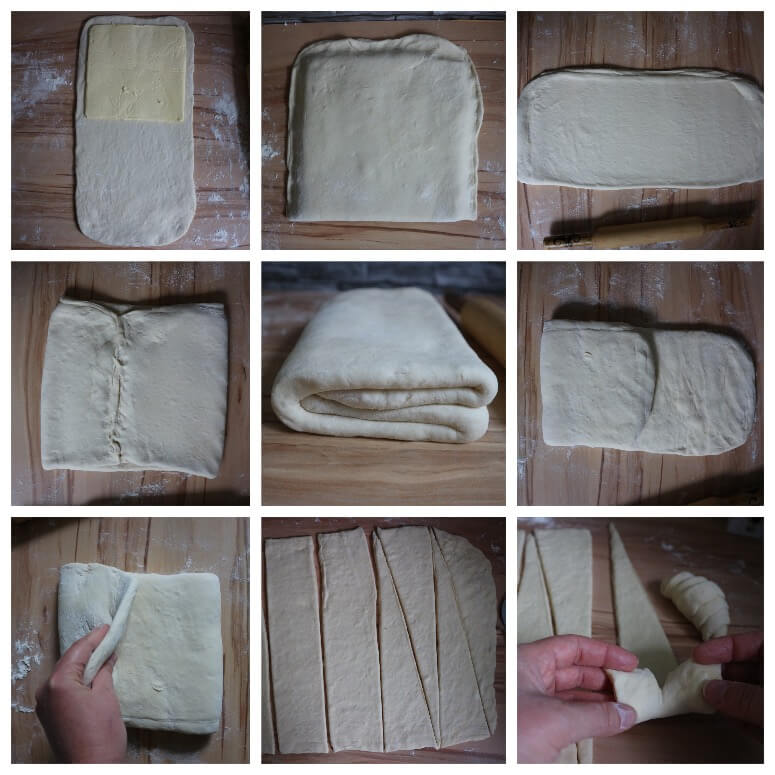Dieser Beitrag ist auch verfügbar auf:
Deutsch
A freshly baked croissant with a crispy crust and a buttery crumb for breakfast, brunch or dessert – who can resist it! Here I show you how to make the most delicious croissants yourself and bring the flair of France with its enchanting aroma and taste to your home. You can find a detailed croissant recipe with exact quantities and step-by-step instructions right below.

Just like in one of the best French cafés
With this recipe, you’ll conjure up the most delicious croissants from one of the best French cafés to bring home to you. Homemade, they taste much better than the store-bought pastry from a bakery. After tasting the freshly baked croissants, you’ll never want to go back to the bakery again.
The secret of the most delicious croissants
The secret of these tastiest croissants lies in the long resting times of the dough. That’s why I recommend you not to shorten them. Because the longer the dough rests, the better its quality will be and the more delicious your croissants will taste in the end.
And during all the resting time you don’t have to stand in the kitchen waiting for the dough, but you can devote yourself to other things.
Plain or with a filling
These homemade croissants taste incredibly delicious plain. They are so airy, soft, buttery, fine, very aromatic and have a slightly crispy top layer.
But you can also fill them with sweet or savory fillings. Sweet fillings such as jam or chocolate are very popular. Hearty you can fill your croissants with grated cheese, cream cheese or herbs.
A real treat for breakfast or dessert
A fresh, still warm croissant straight from the oven with a cup of coffee – doesn’t it sound like a divine breakfast?! With this recipe you can conjure up such a breakfast yourself on the dining table.
But also for dessert with jam or nut-nougat cream, the homemade French pastry is a real treat.
How to make and store croissants?
If you want to serve freshly baked croissants for breakfast, you can form them from the dough the night before, spread them on the baking sheet and put them unbaked in the refrigerator overnight.
The next morning, take them out of the fridge, let them rise at room temperature for about 1.5 hours, and then bake them.
Alternatively, you can freeze unbaked croissants. To do this, spread them out on a floured cutting board immediately after shaping and place them in the freezer. Once frozen, transfer the croissants to a freezer bag.
Before baking, allow the frozen pastry to thaw and rise at room temperature.
These homemade croissants are
- crispy on the outside,
- very airy on the inside,
- fluffy,
- soft,
- buttery,
- flaky,
- fine,
- heavenly delicious,
- aromatic,
- more delicious than from the bakery,
- simple, but with some effort to make with ordinary ingredients,
- ideal for breakfast or dessert,
- classic of French cuisine.
The best croissant recipe
The croissants recipe takes a little time, but otherwise it is not difficult. Here you can form a rough idea of how the preparation is done, and what you need for it. The exact quantities and step-by-step instructions, according to which you can make the most delicious croissants yourself, can be found here below in the box recipe.
For the yeast dough you need
- lukewarm milk and lukewarm water,
- some butter,
- sugar,
- flour,
- yeast – I had fresh yeast
- and some salt.
And for the plunder dough add
- cold butter.
To coat the pastry you need
- room-warm egg.
How to make croissants: this is how it works (See the detailed recipe below.)
- First, knead the yeast dough from all the ingredients and let it rise in the refrigerator for at least 4 hours. Wrap the cold butter in baking paper, roll it into a square and put it in the fridge as well. After that, continue touring the plunder dough as shown here in the pictures, chilling the dough every now and then.
- Now roll out the plunder dough into a rectangle, cut it into long triangles and shape each triangle into a croissant. Let the croissants rise at room temperature, brush them with beaten egg and bake them at 200 °C for 10 minutes and then at 180 °C for another 10 minutes. Done!
How to make croissants: tips and tricks
- Instead of fresh yeast you can use dry yeast for the dough. For the recipe below, you will need 7 g of it.
- The amount of flour given in the recipe may vary. Therefore, add the flour in portions until the dough has the right consistency. It should be very soft and in no case dry or too firm.
- When touring the dough, make sure that the fold of the rectangle on the work surface is on the same side each time it is rolled out and folded.
- Depending on how warm it is in your kitchen, the croissants could take less or more than 1.5 hours to rise before baking. They should visibly increase in size as they do so.
Have you made croissants yourself using this recipe? I look forward to hearing your results, your star rating, and your comment below here on how you liked and succeeded with the French pastry.
Work up an appetite for more sweet pastries from French cuisine? Try also:
- How to make eclairs – recipe for world-famous French choux pastry
- Palmier cookies recipe – how to make sweet pig ear cookies
- How to make macarons – recipe for French almond meringue pastry

How to make croissants
Ingredients
for the dough
- 150 ml milk lukewarm
- 150 ml water lukewarm
- 40 g butter
- 60 g sugar
- approx. 520 g flour
- 21 g fresh yeast
- 1 tsp salt
- flour for the work surface
additionally for the plunder dough
- 250 g cold butter
for the coating
- 1 egg room-warm
Instructions
- Put lukewarm milk and water in a large mixing bowl and dissolve fresh yeast and sugar in it.
- Add salt and flour in portions and knead into a very soft dough.
- Knead 40 g of butter into the dough in pieces and knead the dough for about 10 minutes to make it elastic and smooth. Cover the mixing bowl with the dough with plastic wrap and let the dough rise in the refrigerator for at least 4 hours or overnight (max. 10 hours).
- Fold the baking paper into an envelope of about 20 cm x 20 cm, put 250 g of cold butter cut into thin slabs into it and roll it out with a rolling pin so that it is evenly distributed in the envelope. Put the butter plate in the envelope also in the refrigerator while the dough is rising.
- Dust the work surface with flour and roll out the dough into a rectangle about 21 cm x 41 cm (that is, slightly larger than twice the size of the butter plate).
- Take the butter plate out of the baking paper envelope and place it on one side of the rolled out dough rectangle, leaving a border about 1 cm wide (as shown in the pictures here above). Cover the butter plate with the second half of the dough and press the edge of the dough down on all sides.
- Roll out the buttered dough into a long rectangle, fold in one of the shorter sides of the square about 2/3 to the center, fold in its second side about 1/3 to the center as well, and glue the two sides together. Now fold the dough from the two folded sides together like a book, wrap it in baking paper or plastic wrap, and chill it for 1 hour.
- Roll out the dough sheet again on the floured work surface into a long rectangle, fold one of the shorter sides of the square in half on the center and place the second short side over it. Wrap the dough sheet again in baking paper or plastic wrap and chill for 1 more hour.
- Roll out the dough on the floured work surface to 0.4-0.5 cm thick into a long rectangle (29 cm x 72 cm for me) and cut it from the shorter side into strips about 8 cm wide (9 strips for me). Cut each strip into two triangles (18 triangles for me), cut each triangle about 1 cm deep in the center on the short side, and roll it up from that side toward the tip.
- Slightly bend the croissants lengthwise into a crescent shape and spread them out on two baking sheets lined with parchment paper, spacing them generously apart. Cover them with plastic wrap and let them rise at room temperature for about 1.5 hours.
- First, carefully brush the croissants on the first baking sheet with beaten egg and let them dry for 5 minutes. Bake them in the preheated oven at 200 °C top and bottom heat for 10 minutes, then switch the oven to 180 °C top and bottom heat and bake them for another 10 minutes. Repeat the same with the croissants on the second baking tray.
Notes
- The amount of flour indicated may vary. Therefore, add the flour in batches until the dough has the right consistency. It should be very soft and never dry or too firm.
- When touring the dough, make sure that the fold of the rectangle on the work surface is on the same side each time it is rolled out and folded.
- Depending on how warm it is in the kitchen, the croissants could take less or more than 1.5 hours to rise before baking. They should visibly increase in size as they do so.
- Note the detailed tips and tricks for making the croissants at the top of the post.





